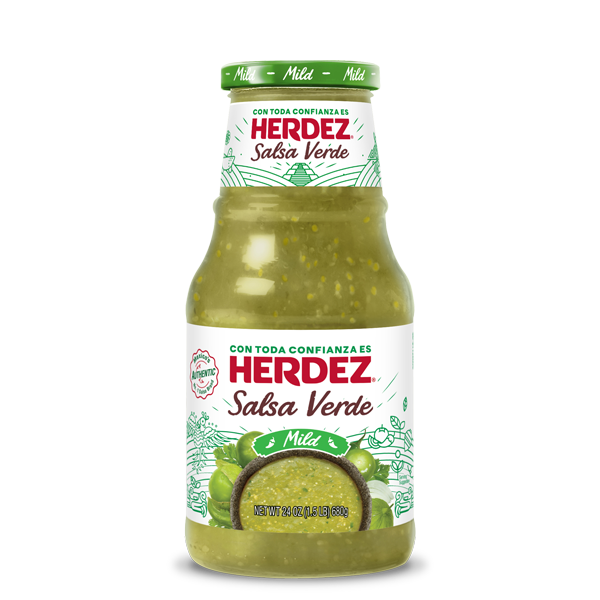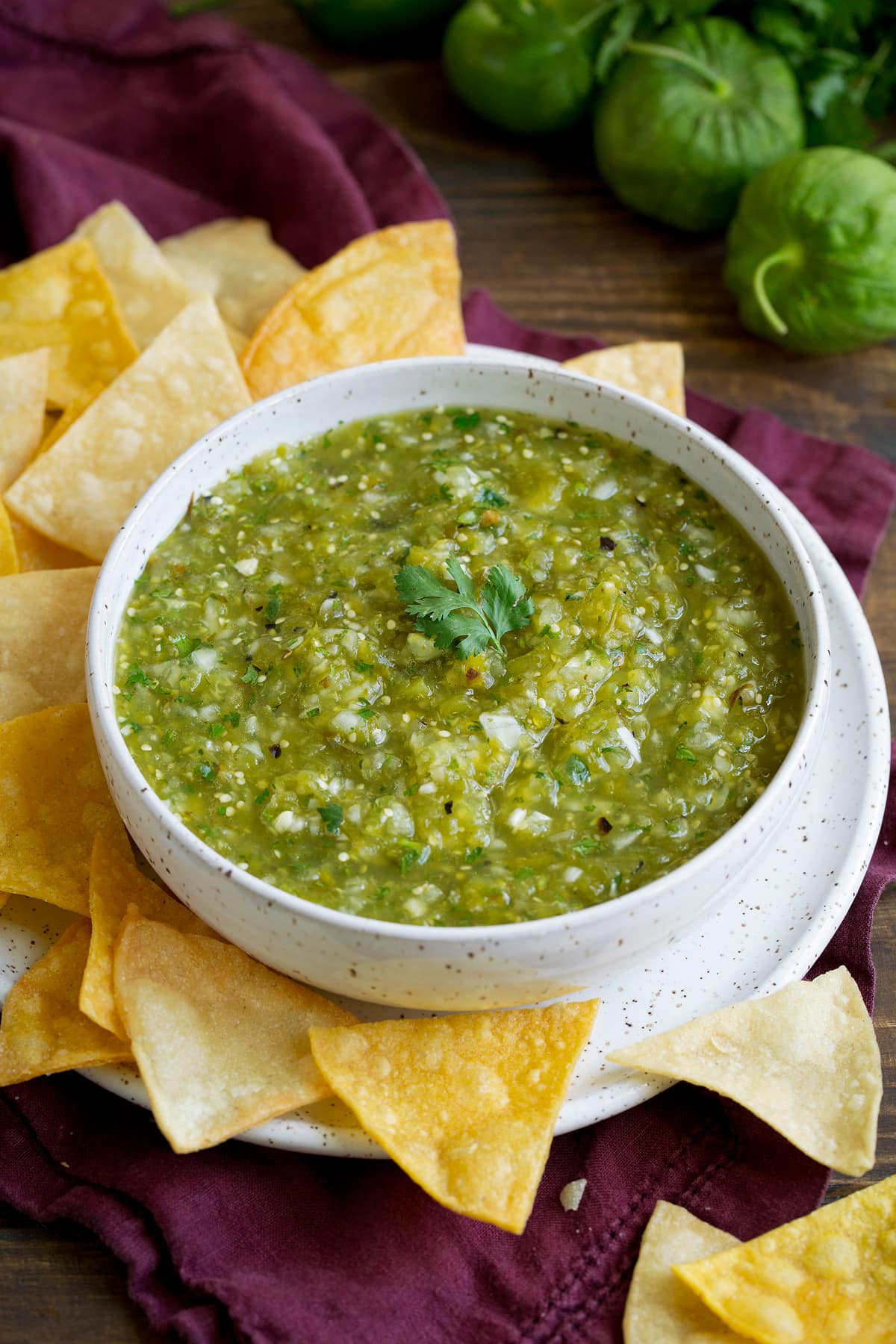Salsa Verde

Salsa Verde is a vibrant, green sauce made from tomatillos, chili peppers, and fresh herbs. It is popular in Mexican cuisine.
Salsa Verde, translating to “green sauce” in Spanish, is a staple in Mexican cooking. It typically features tomatillos, giving it a tangy flavor, combined with chili peppers, garlic, onions, and fresh cilantro. This sauce is versatile, enhancing the taste of tacos, enchiladas, grilled meats, and even tortilla chips.
Homemade salsa verde offers a fresh, zesty alternative to store-bought versions, ensuring a burst of flavor in every bite. Preparing it at home is simple and allows for customization to suit personal heat preferences. With its vibrant color and rich taste, salsa verde is a favorite condiment for many.

Credit: www.salsas.com
Introduction To Salsa Verde
Salsa Verde is a green sauce. It has roots in Mexican cuisine. People use it to flavor many dishes. The main ingredient is tomatillos. The name means “green sauce” in Spanish. Ancient Aztecs used tomatillos in their cooking. Salsa Verde has a fresh, tangy taste. It is a staple in Mexican homes.
There are many types of Salsa Verde. Some are mild, and others are spicy. One popular type uses jalapeños. Another uses serrano peppers. Some recipes add avocado for a creamy texture. Others include cilantro for a fresh flavor. People can also add garlic or lime juice. Each variety offers a unique taste.

Credit: downshiftology.com
Key Ingredients
Tomatillos are small, green fruits. They have a tangy flavor. They come with a paper-like husk. Remove this husk before cooking. Tomatillos are rich in vitamin C. They add a unique taste to Salsa Verde.
Chiles give Salsa Verde its spicy kick. Use jalapeños, serranos, or both. Remove seeds for less heat. Keep seeds for more spice. Roast them for a smoky flavor.
Cilantro is a must for Salsa Verde. It adds a fresh, green taste. Use garlic and onions for depth. Lime juice brings zesty notes. Salt and pepper balance the flavors.
Preparation Methods
Blending makes Salsa Verde smooth and creamy. Use a blender or food processor. Add tomatillos, cilantro, onion, garlic, and lime juice. Blend until the mixture is smooth. Taste and adjust the seasoning if needed. This method is quick and easy.
Cooking enhances the flavors of Salsa Verde. Roast or boil the tomatillos until soft. Combine with cilantro, onion, garlic, and lime juice. Cook the mixture over medium heat for 10 minutes. Stir occasionally to mix well. This method adds depth to the salsa.
Raw preparation keeps ingredients fresh and zesty. Chop tomatillos, cilantro, onion, and garlic finely. Mix them in a bowl. Squeeze lime juice over the mixture. Stir well to combine. This method keeps the salsa light and refreshing.
Health Benefits
Salsa Verde is rich in vitamins and minerals. It contains vitamin C, which helps boost the immune system. This sauce is low in calories, making it a healthy choice. Salsa Verde also has fiber, which aids digestion. Eating this sauce can provide essential nutrients without extra calories.
Salsa Verde is full of antioxidants. These help fight harmful free radicals in the body. Antioxidants can reduce the risk of chronic diseases. This sauce has ingredients like tomatillos and cilantro, which are known for their antioxidant properties. Eating Salsa Verde can help keep your body healthy and strong.
Pairing With Dishes
Salsa Verde goes well with tacos. It adds a fresh taste to burritos. Nachos become more exciting with it. Try it with enchiladas for a zesty flavor. Mexican rice gets a nice kick from Salsa Verde. It pairs wonderfully with grilled meats. Use it as a dip for tortilla chips. Salsa Verde enhances the flavor of quesadillas. Tamales taste even better with a spoonful of it.
Salsa Verde is great with scrambled eggs. It can spice up pasta dishes. Try it on pizza for a unique twist. Use it in sandwiches for a tangy kick. It’s delicious as a salad dressing. Mix it with yogurt for a tasty dip. Add it to soups for a burst of flavor. Use it as a marinade for chicken. It even works well on fish tacos.
Regional Variations
Salsa Verde differs in each Mexican region. In the North, it is often thick. People enjoy it with beef. In Central Mexico, it is tangy and spicy. They love it with tacos and enchiladas. Southern Mexico has a milder version. It is rich in herbs and best with chicken. Each region adds its own twist to Salsa Verde.
Different countries have their own Salsa Verde. Italian Salsa Verde is made with parsley and anchovies. It tastes great with fish and roasted meats. In Argentina, Chimichurri is their version. It is vibrant and garlicky. Perfect for grilled meats. American Salsa Verde often includes tomatillos and green chilies. It pairs well with chips and salsa. Each twist offers a unique flavor.
Storing And Preserving
Salsa Verde can stay fresh in the fridge for about a week. Store it in an airtight container to keep the flavors strong. Always use a clean spoon to scoop out the salsa. This helps prevent contamination. Make sure to label the container with the date. That way, you know how long it’s been in the fridge.
Freezing is a great way to keep Salsa Verde for a longer time. Pour the salsa into ice cube trays for easy portioning. Once frozen, transfer the cubes to freezer bags. Squeeze out as much air as possible. Label the bags with the date for easy tracking. Salsa Verde can last up to six months in the freezer.

Credit: www.cookingclassy.com
Diy Salsa Verde
To make Salsa Verde, you need fresh ingredients. Gather tomatillos, jalapeños, onions, and cilantro. Also, have garlic, lime juice, and salt ready. Start by boiling the tomatillos and jalapeños. Blend them with onions, cilantro, garlic, and lime juice. Add salt to taste. Chill before serving. Enjoy with chips or tacos.
If the salsa is too spicy, add more tomatillos. For less tangy salsa, reduce lime juice. If it’s too thick, add water. To make it thicker, use less water. Always taste and adjust salt. Store in the fridge for up to a week. Fresh salsa tastes best.
Commercial Options
Some brands make very tasty salsa verde. Herdez is a popular choice, known for its fresh flavor. La Costeña offers a spicy option for those who love heat. Frontera provides a gourmet experience with its rich taste. Each brand brings something unique to the table.
Ingredients are the first thing to check. Look for natural items like tomatillos, jalapeños, and cilantro. Avoid products with too many preservatives. Texture is also important. It should be smooth but have some chunkiness.
Taste can vary. Some may be tangy, others more spicy. It’s good to try different brands to find your favorite. Packaging matters too. Glass jars often keep the salsa fresher than plastic ones.
Frequently Asked Questions
What Is Salsa Verde Made Of?
Salsa Verde is typically made of tomatillos, cilantro, jalapeños, lime juice, garlic, and onions.
Is Salsa Verde Spicy?
Yes, Salsa Verde can be spicy due to the jalapeños. Adjust the amount for your preferred heat level.
How Long Does Salsa Verde Last?
Salsa Verde lasts up to one week in the refrigerator when stored in an airtight container.
Can I Freeze Salsa Verde?
Yes, you can freeze Salsa Verde. Store it in a freezer-safe container for up to three months.
Is Salsa Verde Healthy?
Salsa Verde is low in calories and packed with vitamins from fresh ingredients like tomatillos and cilantro.
Conclusion
Salsa Verde is a versatile and delicious addition to any meal. It brings a zesty and fresh flavor. Try it with tacos, grilled meats, or as a dip. You’ll love its simple ingredients and vibrant taste. Make your meals more exciting with homemade Salsa Verde.
Enjoy the burst of flavor in every bite!



